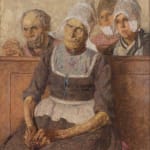Wilm Wouters (1887–1957)
Wilm Wouters was born in The Hague in 1887. From 1909 to 1914, he was enrolled at the Rijksakademie and studied with Nicolaas van der Waay in Amsterdam. In 1918, Wouters moved to the village of Volendam, changing his life forever.[1] In search of the “unspoiled” life of the villagers, from the 1880s onwards, artists from all over the world had become enamored of all things Dutch, and arrived in droves to search for what they considered the “true” Holland. Volendam, eleven miles north of Amsterdam, was a remote fishing village accessible only by boat or carriage. Such isolation had left Volendam largely untouched by the modernization and industrialization dominating cities. Wouters lived in Volendam until 1925, when he returned to Amsterdam.
The Hotel Spaander was one of Volendam’s principal attractions. Entrepreneurial innkeeper Leendert Spaander (1855-1955) decorated the hotel with historic rooms to rent out to artists. For an additional fee, he would supply models, often one of his seven daughters. His youngest, Conny, married Wouters in 1919, solidifying the artist’s connection to Volendam. At Hotel Spaander, art accumulated from unsettled debt, attracting tourists to visit the ever-expanding collection. Americans like Andrew Carnegie, William Randolph Hearst, Clark Gable, Elanor Roosevelt, and Walt Disney all flocked to the picturesque village, proliferating Holland mania at home.[2] Between 1880 and 1920, Americans embraced the colonial Dutch influence repudiating England over Holland.
The traditional costumes and tiny wooden houses crammed with objects appealed to the imagination of artists and collectors alike. One of the most popular artist’s models was Geertje Pieters Karregat (1837-1924), nicknamed the Savior (Zaligmaker), emblematic of Volendam. Geertje was married to the fisherman Jan Pooijer Pantjes (1828-1898) with whom she had eight children, five of whom Geertje survived. They lived in a tiny house in the Doolhof (Maze) on a narrow street in the oldest part of Volendam. An embalmer by day, Geertje disrobed the deceased, washed and then dressed them in burial clothes for their viewing. On the occasion to bid farewell, Geertje recited the rosary. These prayers had to ensure that the deceased went to heaven, or be saved, hence her nickname the Savior. Most likely, Geertje would be remunerated for this service of reading prayers as it was called in those days.
This would explain why Geertje is depicted in the pew of the seventeenth century Protestant Stolphoevekerkje. The Protestant community in Volendam’s predominantly Catholic enclave, was never big. However, the 1658 church is older than most of the houses, providing a perfect backdrop for the idealized world of the villagers. Geertje’s gaze, locked with the painter, is posing again as a model while also praying for the peaceful passing of the widower’s wife and mother of the young children behind her. A slightly smaller version of this painting is in the collection of Hotel Spaander.[3] Cropped differently, it shows stronger contrasts in coloration, whereas the present monochromatic palette lends an ethereal quality to the narrative.
[1] Dick Brinkkemper, Peter Kersloot & Kees Sier, Volendam schildersdorp, 1880-1940, Zwolle 2006, p. 126
[2] Annette Stott, Holland Mania, Woodstock, NY 1998, pp. 44-45
[3] Piet Koning, Wilm Wouters. En zijn toevlucht Voldendam, Volendam 2015, p. 59. The work was exhibited at Arti et Amicitiae in Amsterdam in 1923 and offered for sale for 250 guilders.
Provenance
Private collection, The Netherlands
Exhibitions
Enkhuizen, Zuiderzeemuseum, Volendam Kunstenaarsdorp het Erfgoed van Hotel Spaander (Volendam Artists Village, The Heritage of Hotel Spaander), 11 November 2009 – 2 May 2010
Volendam, Volendams Museum, Wilm Wouters schildert Volendam, 15 March – 8 November 2015
Literature
Brian Dudley Barrett & André Groeneveld, Volendam Kunstenaarsdorp het Erfgoed van Hotel Spaander (Volendam Artists Village, The Heritage of Hotel Spaander), exh.cat. Enkhuizen 2009, p. 149, ill.
“Wilm Wouters Schildert Volendam” in de-Maarschalk, March 10, 2015, ill.



